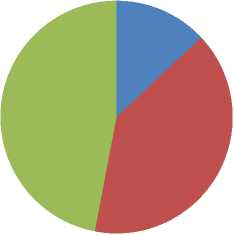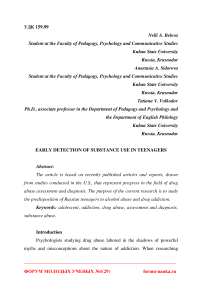Early detection of substance use in teenagers
Автор: Belova N.A., Sidorova A.A., Volkodav T.V.
Журнал: Форум молодых ученых @forum-nauka
Статья в выпуске: 1-1 (29), 2019 года.
Бесплатный доступ
The article is based on recently published articles and reports, drawn from studies conducted in the U.S., that represent progress in the field of drug abuse assessment and diagnosis. The purpose of the current research is to study the predisposition of Russian teenagers to alcohol abuse and drug addiction.
Adolescent, addiction, drug abuse, assessment and diagnosis, substance abuse
Короткий адрес: https://sciup.org/140284447
IDR: 140284447 | УДК: 159.99
Текст научной статьи Early detection of substance use in teenagers
Psychologists studying drug abuse labored in the shadows of powerful myths and misconceptions about the nature of addiction. When researching addictive behavior in the 1930s, they treated it as a moral failing rather than a health problem, which led to an emphasis on punishment rather than prevention and treatment. Nowadays our views and our responses to addiction and other substance use disorders have changed dramatically: we know that addiction is a disease that affects both the brain and behavior [1]. Despite this, many people still fail to understand why people become addicted to drugs or how drugs change the brain to foster compulsive drug use.
Addiction is defined as a chronic, relapsing brain disease that is characterized by compulsive drug seeking and use, despite harmful consequences. It is considered a brain disease because drugs change the brain — they change its structure and how it works. The term addiction may be regarded as an equivalent to a severe substance use disorder [2].
According to the National Survey of Drug Use and Health (NSDUH), Americans annually consume significant amounts of alcohol, tobacco, prescription opioids, and illegal drugs. NSDUH estimated that in 2014, 52.4% of U.S. citizens aged 12 or older were currently using alcohol, 25.4% were using tobacco, 8.0% were using marijuana, 3.3% were using some other type of illicit drug, and in the past year, 4.1% had taken prescription opioids for nonmedical purposes. This level of substance use has resulted in substantial economic and social consequences and represents a significant public health challenge for the nation [3]. Loss of life is the most serious outcome related to substance use; 44,827 U.S. deaths in 2015 were tied to alcohol or drug use [4], and an additional 480,000 deaths were attributable to tobacco use [5].
Although substance abuse at any age can adversely affect the brain, there are critical periods when it can have substantially greater impact on the person’s development. One of these critical periods is adolescence. The use of substances during this phase of development has been tied to many negative, long-term consequences. During adolescence, which begins at approximately 12 years old and lasts till 20, the brain changes rather dramatically. At the behavioral level, the maturation process of the adolescent brain is reflected in the greater propensity to risky activities such as unprotected sexual activity, reckless driving, and substance use, than at any other point in their lives [6]. Adolescents begin to act out, do poorly academically, and drop out of school. They are at risk for unplanned pregnancies, violence, and infectious diseases. Most peoples’ first exposure to alcohol, tobacco, and other drugs typically occurs at some point during adolescence. Data from several sources indicate that the rate of substance use begins to increase when children enter the 8th grade and peaks when they reach their late teens or early twenties [7].
Substance use and especially substance use disorder is an “equalopportunity destroyer” because it affects families of all socioeconomic backgrounds. For example, some forms of substance use during adolescence, like cigarette smoking, are consistently associated with socioeconomic disadvantages, whereas other forms, such as excessive drinking, appear to disproportionately affect upper-middle-class families [8]. Meanwhile, what might be more predictive of risk than an individual’s socioeconomic status is the level of acceptance of marijuana at school [9, c. 1-10]. However, one common denominator across many studies is the importance of parents. Parental knowledge, attitudes and behaviors can reduce the risk for adolescent and young adult substance use. In a review of several well-designed studies that measured substance use during adolescence into young adulthood, parental monitoring was shown to be the strongest parental protective factor predicting reduced alcohol use and misuse [compared to parent-child relationship quality, parental support and parental involvement [10, c. 1142-1162].
Parents, teenagers and teachers working together can a) limit adolescent access to alcohol, cigarettes, and marijuana; b) increase adolescent-specific treatment services; c) provide training to healthcare and other professionals on how substance use can affect the brain, how to identify signs of substance use, and how to effectively intervene [11, c. 26-33].
Materials and Methods
The aim of the current study is to identify the predisposition of adolescents to the use of psychoactive substances. For the convenience of data collection, a 9-item questionnaire was used for the predisposition of N=40 respondents to the use of psychoactive substances (Table 1). The study was conducted in the 9th grade with the teenagers aged from 14 to 15 years old.
Table 1. “The predisposition of a teenager to the use of substances”
|
The questionnaire scales |
Yes (%) |
No (%) |
|
1.Low resistance to physical activity and stress. |
40,3 |
59,7 |
|
2. Self-doubt, low self-esteem. |
45,6 |
54,4 |
|
3. Difficulties in communicating with peers on the street. |
10,5 |
89,5 |
|
4. Anxiety, tension in communication at school. |
11,2 |
88,8 |
|
5. The desire to get new sensations, pleasure, as quickly as possible and/or by no means. |
32,6 |
67,4 |
|
6. Excessive dependence on friends, easy subordination to the opinion of friends, uncritical willingness to imitate the lifestyle of a friend. |
28,9 |
71,1 |
|
7. Behavioral disorders caused by brain injuries, infections or congenital diseases, including those associated with brain pathology. |
5,1 |
94,9 |
|
8. Intolerance of conflicts, the desire to go into the illusory world of well-being. |
16,3 |
83,7 |
|
9. Genetic predisposition caused by father’s (mother’s) drug addiction or alcoholism. |
0 |
100 |
Results and Discussion
Analyzing the data obtained, we can conclude that the high predisposition was revealed in 13% of the respondents; the average susceptibility was registered in 40% of the subjects; the low probability of predisposition was diagnosed in 47% of the respondents (Figure 1).

-
■ high predisposition
-
■ average
predisposition
-
■ low predisposition
-
Figure 1: Results of the study
Thus, the results suggest that in the sample 47% of the respondents have demonstrated a low level of predisposition to the use of substances; therefore, the adolescents are not included in the risk group. The average level of predisposition to the use of substances was found in 40% of adolescents, which can be attributed to the risk group, that might need the help of a psychologist and a social worker. In 13% of the studied adolescents, a high level of predisposition to the use of substances was revealed, which requires a comprehensive evaluation by a licensed clinician, such as a psychologist, or psychiatrist.
Conclusion
Continued research efforts are needed to further refine assessment practices and standards and to better understand how to define a substance use disorder in youth. To decrease the level of predisposition to psychoactive substances, schools must adopt science-based policies and programs that reduce drug abuse and addiction in teenagers. An increased understanding of addiction will empower teenagers to make health choices and decisions in their own lives. Parents of all socioeconomic backgrounds can also benefit from more researchbased tools and resources, which will help them understand how they can be positive role models for their children and engage in behaviors that might reduce their children’s risk of early involvement in substance use.
Список литературы Early detection of substance use in teenagers
- Winters KC. Advances in the science of adolescent drug involvement: Implications for assessment and diagnosis. Experience from the United States. Curr Opin Psychiatry. - 2013. - Retrieved from URL: https://www.ncbi.nlm.nih.gov/pmc/articles/PMC3670700/.
- Diagnostic and Statistical Manual of Mental Disorders, Fifth Edition. DSM-5. - 2013.
- Center for Behavioral Health Statistics and Quality, Behavioral health trends in the United States: Results from the National Survey on Drug Use and Health. 2015: Substance Abuse and Mental Health Services Administration - Rockville, MD.
- National Center for Health Statistics, CDC WONDER Detailed Mortality - 2017. - U.S. Department of Health and Human Services, Center for Disease Control and Prevention: Atlanta, GA.
- Campaign for Tobacco Free Kids. The toll of tobacco in Indiana. - 2017. - Retrieved from URL: https://www.tobaccofreekids.org/facts_isues/toll_us/indiana.
- Gassman R., et al., Indiana Youth Survey. - 2016. - Indiana Prevention Resource Center: Bloomington, IN.
- Miech R., et al., Monitoring the future national survey results on drug use, 1975-2016: Volume I, secondary school students. - 2017. - Institute for Social Research, the University of Michigan: Ann Arbor, MI.
- Luthar S. S., Small P. J., & Ciciolla L. Adolescents from upper middle-class communities: Substance misuse and addiction across early adulthood. Development and Psychopathology.
- Milliren C. E., Richmond T. K., Evans C. R., Dunn E. C., & Johnson R. M. Contextual effects of neighborhoods and schools on adolescent and young adult marijuana use in the United States. Substance Abuse: Research and Treatment, 11. - 2017.- C. 1-10.
- Yap M. B. H., Cheong T. W. K., Zaravinos-Tsakos F., Lubman D. I., & Jorm A. F. Modifiable parenting factors associated with adolescent alcohol misuse: A systematic review and meta-analysis of longitudinal studies. Addiction, 112(7). - 2017.- C. 1142-1162.
- Gogliettino A.R., Potena M.N., Yip S.W. White matter development and tobacco smoking in young adults: A systematic review with recommendations for future research. Drug and Alcohol Dependence. - 2016. - 162: C. 26-33.


